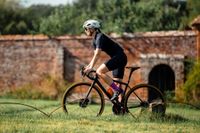What is the Epstein-Barr virus which Mark Cavendish has been diagnosed with?
The virus - which causes glandular fever - stays in your bloodstream forever and can become active months or years after the first diagnosis


Mark Cavendish will take an extended break from racing having been diagnosed with the Epstein-Barr virus.
The virus can become infectious mononucleosis, otherwise known as glandular fever - a condition which affected the Manxman over the first half of the 2017 season.
The 33-year-old, who was eliminated from the Tour de France on stage 11 after missing the time cut, pulled out of the European Championships in August on medical advice.
Tests have shown that he was riding with the the virus "over recent months."
The Team Dimension Data rider commented: “This season I’ve not felt physically myself and despite showing good numbers on the bike I have felt that there’s been something not right.”
“Given this and on the back of these medical results, I’m glad to now finally have some clarity as to why I haven’t been able to perform at my optimum level during this time," he added.
What is the Epstein-Barr virus (EBV)?
The latest race content, interviews, features, reviews and expert buying guides, direct to your inbox!
Epstein-Barr is the virus that causes mononucleosis (mono), or glandular fever.
The virus can be spread by an infected person via saliva. It's colloquially called the 'kissing disease' but you can pick it up as easily as through sharing a glass with an infected person.
In rare cases it can also be spread via blood or other bodily fluids.
What are the symptoms of the Epstein-Barr virus?
EBV can cause no symptoms at all - some people can carry the virus and suffer no negative effects.
However, about 30 to 50 per cent of people will begin to suffer with the symptoms of mono around four to seven weeks after being infected with EBV.
Symptoms include severe fatigue, fever, lack of appetite, a rash, sore throat, swollen glands and weakness and sore muscles - none of which are ideal for a pro cyclist.
The illness causes a large number of white blood cells in the bloodstream.
Around half of people infected also have an enlarged spleen. The spleen filters blood, and most people feel no symptoms of this - but it can rupture if injured, and this can be life threatening.
How long does it take to feel better?
Mono, or glandular fever, typically improves in around two to four weeks, but it can hang around for up to six months.
The virus stays in your body after you recover from mono, and it can become active months or years later - without causing symptoms. Infected people can pass the virus on, usually through saliva, at times that it is active.
EBV is most conclusively diagnosed via a blood test and as it is a virus it cannot be treated with antibiotics.
There is no specific cure, aside from rest, and staying away from any sport is advised.
Michelle Arthurs-Brennan the Editor of Cycling Weekly website. An NCTJ qualified traditional journalist by trade, Michelle began her career working for local newspapers. She's worked within the cycling industry since 2012, and joined the Cycling Weekly team in 2017, having previously been Editor at Total Women's Cycling. Prior to welcoming her first daughter in 2022, Michelle raced on the road, track, and in time trials, and still rides as much as she can - albeit a fair proportion indoors, for now.
Michelle is on maternity leave from April 2025 until spring 2026.
